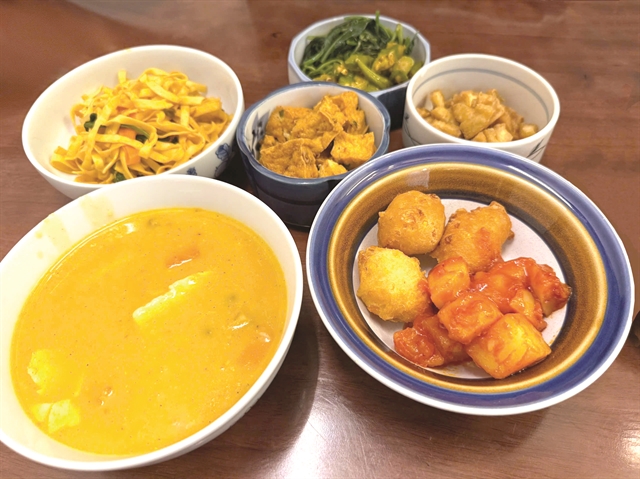 Economy
Economy


|
| Conference on Agriculture and Agricultural Mechanisation in Việt Nam, co-organised in Hà Nội by the Institute of Agricultural Mechanics and Post-harvest Technology, Ministry of Agriculture and Rural Development, and the Italian Embassy in Hà Nội on Monday, January 15. VNS Photo Tố Như |
HÀ NỘI – Việt Nam aims to produce agricultural products with high quality and greater added value, to better participate in global value chains and build national Vietnamese agricultural brands.
Deputy Minister of Agriculture and Rural Development Phùng Đức Tiến made the comment in the Conference on Agriculture and Agricultural Mechanisation in Việt Nam, co-organised in Hà Nội early this week, by the Institute of Agricultural Mechanics and Post-harvest Technology, Ministry of Agriculture and Rural Development and the Italian Embassy.
The agriculture sector would mobilise social resources to invest in developing agricultural and rural infrastructure and agricultural support services, said Tiến.
On behalf of the Ministry of Agriculture and Rural Development (MARD), Tiến pledged to research and come up with mechanisms and policies to encourage and support businesses to co-operate with the international community, in order to promote land accumulation for large-scale agricultural production.
“This is the core factor before accelerating and promoting mechanisation, improving quality, efficiency and reducing losses in agriculture,” Tiến told the conference.
He hoped that relevant parties, especially associations and machinery enterprises from Italy, will conduct in-depth research and invest in agricultural machinery suitable for the Vietnamese market.
According to the ministry, last year the agriculture sector had a trade surplus of more than US$12 billion and gained a growth rate of 3.83 per cent - a record high in many years.
However, there are still limitations such as small-scale production that accounts for a relatively high proportion, and low labour productivity and mechanisation rate.
"The competitiveness of the industry, therefore, has not created resilience, causing significant obstacles to improving quality, value, and building brands in the international arena," said the deputy minister.
Another weakness is that the increase in processing and deep processing rates of the industry has been slow in the past few years. The export volume of agricultural, forestry and fishery products continues to increase, but exports are still mainly in raw form, he said.
This is due to the relatively low level of science and technology and the ability to apply science and technology and national quality standards and regulations being still limited.
According to Phạm Anh Tuấn, director of the Institute of Agricultural Mechanics and Post-harvest Technology, the level of mechanisation in Việt Nam’s agriculture is still low compared to other countries in the region and the world.
Typically, the forestry sector has the lowest level of synchronous mechanisation, only about 30 per cent. It is because the forestry production depends largely on terrain and farming conditions.
“Therefore, to increase added value and sustainable development of Vietnamese agriculture, the solution is synchronous mechanisation,” Tuấn said.
The agricultural sector has set a goal of synchronous mechanisation by 2030, with forestry reaching 50 per cent, cultivation reaching 70 per cent, livestock raising - 60 per cent, aquaculture production – 90 per cent, fishing and preservation – 95 per cent and salt industry – 90 per cent.
Currently, the agricultural machinery market in Việt Nam has great potential but faces some challenges.
Motorised equipment still lags behind the average equipment level in ASEAN countries.
Domestic manufacturers have a relatively low market share and domestic machinery production capacity can only meet 32 per cent of market demand.
A significant share of market demand is supplied by imported products, accounting for about 60 – 70 per cent.
Supporting industry is one of bottlenecks, Tuấn said.
He hoped that Italian businesses will invest in this field, helping Việt Nam integrate, access technology faster and increase the rate of mechanisation in agriculture.
Italian Ambassador to Việt Nam Marco Della Seta highly appreciated the development potential of Việt Nam, a country with a population of nearly 100 million people, as it offers many opportunities for businesses that want to export or establish business activities in the agriculture sector.
Việt Nam’s economy demonstrates outstanding dynamism with strong GDP growth of 8.02 per cent in 2022, making it the third largest economy in the ASEAN region and the 27th largest globally by 2028, Seta said.
Inflation is controlled, the unemployment rate is lower than 2 per cent in 2022, the ratio of public debt to GDP is decreasing and the country has become an attractive destination for global economic and business development, he said.
Fabio De Cillis, director of the embassy’s Trade Office in Việt Nam, assessed that foreign businesses, especially Asian suppliers from China, Korea and Japan, are dominating the Vietnamese market.
European businesses have limited coverage in the Vietnamese market. Italy often holds a position among the top 20 agricultural machinery suppliers to Việt Nam, he said.
He recommended that the development of smart agriculture is one of the directions in restructuring the agricultural sector and combatting climate change in Việt Nam.
This is an opportunity for Italian businesses to contribute to the development of smart farming methods, with affordable solutions highly adapted to the local needs of farmers, he added.
Remi Nono Womdim, FAO representative in Việt Nam, said the world is changing extremely rapidly. Therefore, the agricultural sector must also continuously innovate and apply extensive science and technology to agricultural mechanisation.
This is also the basis to focus more on developing and enhancing machinery and equipment, contributing to the successful transformation of the food system.
Mechanisation plays an extremely important role, has clearly shown itself in Việt Nam in the overall success of the rice industry, and is also a way for managers to show more concern for farmers, he said. VNS